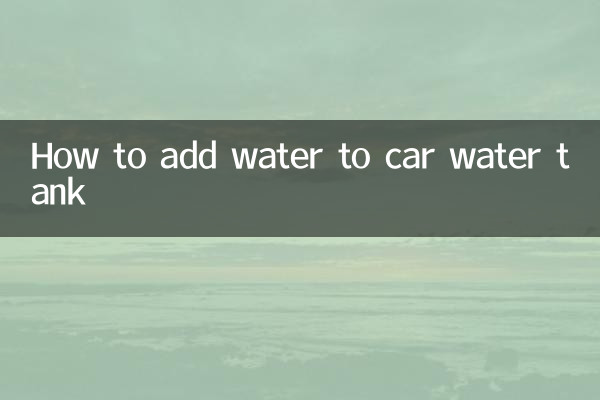How to Fill a Car Water Tank: Detailed Steps and Precautions
The car water tank is an important part of the engine cooling system. Regular inspection and correct addition of coolant is the key to ensuring the normal operation of the vehicle. The following are hot topics and practical guides on filling car water tanks in the past 10 days on the Internet to help car owners easily complete this operation.
1. Preparations before filling the car water tank

The following tools and materials need to be prepared before operation:
| Items | Purpose |
|---|---|
| Antifreeze coolant | It is recommended to use the same model as the original car |
| Distilled water (emergency backup) | Temporary replacement coolant |
| rubber gloves | Protect skin from chemicals |
| funnel | Avoid liquid splashing |
| clean rag | Wipe up spilled liquid |
2. Operation steps for adding water to the water tank (carry out when the car is cold)
| steps | Detailed description |
|---|---|
| 1. Position the water tank | Open the engine compartment and find the translucent fluid reservoir marked "Coolant" or "Water Tank" |
| 2. Check the fluid level | Observe the MIN/MAX scale line on the side of the liquid storage tank. The liquid level should be between the two. |
| 3. Open the cover to exhaust air | Slowly unscrew the pressure cap (do not operate when the car is hot) to release the residual pressure |
| 4. Add liquid | Slowly pour coolant through the funnel to 1cm below the MAX line |
| 5. Check the seal | Make sure the pressure cap is tightened in place to avoid leaks |
3. Answers to hotly discussed questions across the Internet
| High frequency problem | Professional advice |
|---|---|
| Can I use tap water directly? | Not recommended, tap water is prone to scale, so distilled water or special coolant should be used |
| Coolant mixing ratio | Usually 1:1 (coolant: distilled water), please refer to the product description for details |
| How often should it be replaced? | Generally 2 years or 40,000 kilometers, whichever comes first |
| Reasons why the liquid level drops too fast | It may indicate that there is a leak and needs to be repaired in time. |
4. Precautions and safety warnings
1.Hot car operation is strictly prohibited: When the cooling system is working, the internal pressure can reach 200kPa, and high-temperature liquids may cause serious burns.
2.Color matching principles: Different colors of coolant have different chemical compositions, and mixing may cause precipitation.
3.Environmentally friendly treatment: Wasted coolant is hazardous waste and needs to be recycled by professional organizations.
4.Emergency treatment: You can prepare 1L of coolant for long-distance driving, but you should replace the regular coolant as soon as possible after temporarily adding water.
5. The latest trend: intelligent cooling system monitoring
Recent hot automotive technology topics show that among the new models in 2023:
| Technical name | Features | Proportion of equipped models |
|---|---|---|
| Liquid level sensor | Real-time monitoring and reminder | 62% |
| pH value monitoring | Check the degree of coolant acidification | 28% |
| automatic replenishment system | High-end model equipment | 9% |
Through the above structured guidance, car owners can complete the water tank filling work safely and efficiently. It is recommended to check the coolant status once a quarter to ensure driving safety. If any abnormality is found, professional maintenance personnel should be contacted promptly.

check the details

check the details